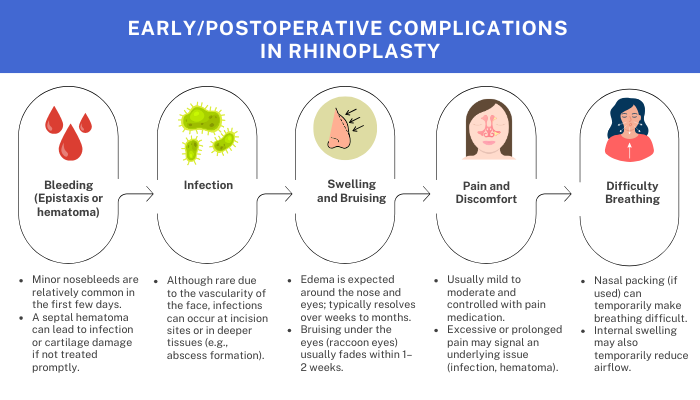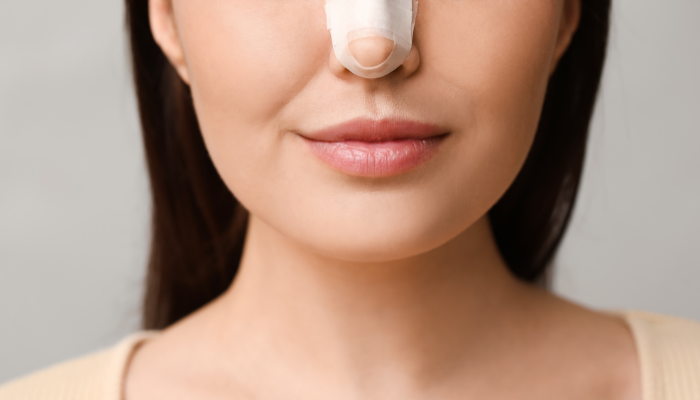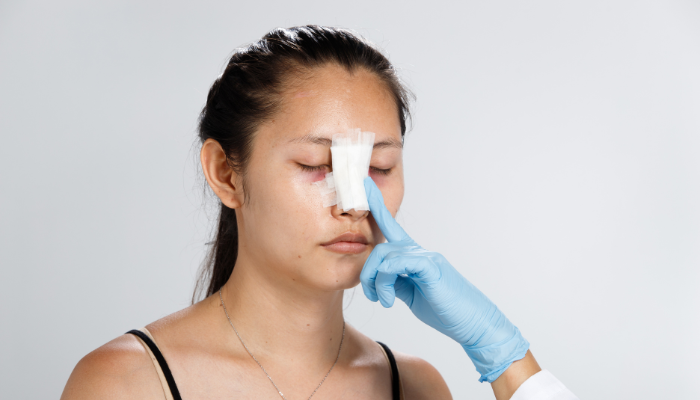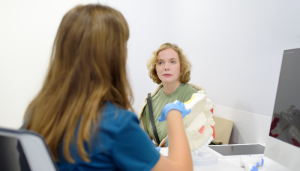Rhinoplasty is one of the most popular cosmetic surgeries in the world. But while the results can be life-changing, it’s important to know that, like any surgery, it comes with risks.
From swelling and scarring to breathing issues, understanding the common complications can help you stay informed, prepared, and in control. In this guide, we’ll break down the most frequent rhinoplasty complications and show you how to manage (or avoid) them with confidence.
Key Takeaways
- Rhinoplasty complications can be broadly classified into aesthetic, functional, and psychological issues.
- Infections are a significant risk; recognising symptoms early can lead to better outcomes.
- Managing aesthetic complications often requires revision surgery, and patient expectations must be realistic.
- Breathing difficulties post-surgery should be addressed promptly to avoid long-term issues.
- Postoperative care and choosing a skilled surgeon are key to minimising complications.
Understanding Rhinoplasty Complications
Rhinoplasty, like any surgical procedure, carries potential risks. It’s easy to get caught up in the excitement of the potential outcome, but it’s really important to be aware of what could go wrong. Most complications are manageable, especially when identified early. Being informed is the first step towards a smooth recovery.
Types of Complications

Rhinoplasty complications can be broadly categorised. You’ve got aesthetic issues, where the nose doesn’t quite look as expected. Then there are functional problems, like breathing difficulties.
Infections are another risk, as with any surgery. And let’s not forget the psychological impact – sometimes the emotional adjustment can be tough. It’s a good idea to be aware of all these possibilities before you go ahead.
Common Symptoms to Watch For
Okay, so what should you actually look out for after your rhinoplasty? Well, excessive bleeding or persistent pain that doesn’t respond to medication is a red flag. Signs of infection, like redness, swelling, or pus, need immediate attention.
Breathing problems that weren’t there before, or a sudden change in your sense of smell, are also things to keep an eye on. And if you’re just feeling really down or anxious about the results, that’s important too. Don’t just brush it off.
When to Seek Medical Attention
If you experience a high fever, uncontrolled bleeding, or severe pain, don’t wait – get in touch straight away. Any signs of infection warrant a prompt call too. And if you’re struggling to breathe, that’s an emergency.
It’s always better to err on the side of caution. Your surgeon is there to support you, so don’t hesitate to reach out if you’re worried.
It’s worth remembering that everyone’s experience is different. What might be a normal part of the healing process for one person could be a sign of a complication for another. So, trust your instincts and don’t be afraid to seek advice if something doesn’t feel right.
Infection Risks and Management
Look, no one wants to think about infection after surgery, but it’s something we need to address head-on. It’s not super common after a rhinoplasty, but being prepared is always a good shout. Let’s break down what to look for and how to handle it.
Signs of Infection
So what are the red flags? It’s not just about a bit of redness – we’re talking about stuff that’s clearly not right. Keep an eye out for increasing pain, swelling that seems excessive, pus or discharge from the incision sites, and a fever. If you spot any of these, don’t sit on it – get in touch with your surgeon.
Here’s a quick checklist:
- Increased redness around the incision
- Persistent throbbing pain
- Yellow or green discharge
- Fever (over 38°C)
- Unusual swelling
Preventative Measures
What can you do to lower your risk? First off, stick to your surgeon’s post-op instructions like glue. That means keeping the area clean and dry, and avoiding touching your nose unless you absolutely have to.
Also, your surgeon might prescribe antibiotics as a preventative measure. Take them exactly as prescribed – no skipping doses!
Treatment Options
Right, so you suspect an infection. What’s next? First, don’t panic. Your surgeon will likely prescribe antibiotics to fight the bacteria. For minor infections, oral antibiotics might do the trick.
But if it’s more serious, you might need intravenous antibiotics in hospital. In some cases, the surgeon might need to drain any abscesses that have formed.
Aesthetic Complications and Solutions

Let’s be honest, sometimes rhinoplasty doesn’t go exactly as planned. It’s a complex procedure, and while most people are happy with their results, aesthetic issues can crop up.
The good news is that many of these can be addressed, and it’s all about understanding what’s gone wrong and how to fix it.
Common Aesthetic Issues
So, what are some of the things people might not be thrilled with after a nose job? Well, there’s a whole range. We’re talking about things like:
- Asymmetry: One side of the nose looking different from the other.
- Tip Issues: A tip that’s too pointy, too bulbous, droopy, or upturned.
- Dorsal Irregularities: Bumps or dips along the bridge of the nose.
- Breathing Problems: Although primarily functional, can also affect the appearance.
- Unnatural Appearance: A nose that just doesn’t quite fit the face.
These issues can arise from a number of factors, including surgical technique, healing processes, and even the patient’s own anatomy. It’s important to remember that everyone heals differently, and what looks great on one person might not on another.
Revision Rhinoplasty
If you’re dealing with an aesthetic complication, revision rhinoplasty might be an option. This is basically a second surgery to correct the issues from the first one. It’s important to wait at least a year after your initial surgery before considering revision rhinoplasty, as it can take that long for all the swelling to go down and for the tissues to settle.
Revision surgery can be more complex than the original procedure, as the surgeon is working with altered tissue and scar tissue. It’s absolutely vital to choose a surgeon with extensive experience in revision cases. They’ll need to carefully assess the issues and develop a plan to address them. This might involve:
- Grafting: Using cartilage or bone to reshape the nose.
- Suturing Techniques: To refine the tip or nostrils.
- Osteotomies: To reshape the nasal bones.
It’s worth noting that revision rhinoplasty isn’t always a guaranteed fix. Sometimes, the best outcome is an improvement rather than perfection. It’s all about having realistic expectations and working with your surgeon to achieve the best possible result.
Patient Expectations
Speaking of expectations, this is a big one. Before even considering rhinoplasty, it’s crucial to have a really honest conversation with your surgeon about what’s achievable. Bring photos of noses you like, but understand that your own anatomy will play a big role in the final outcome.
It’s also important to be aware of the limitations of surgery. Rhinoplasty can make a big difference, but it won’t transform you into a completely different person. The goal is to create a nose that’s in harmony with your other facial features and that you feel confident about. If you go into surgery with realistic expectations, you’re much more likely to be happy with the results, even if they’re not absolutely perfect.
Functional Complications and Their Management
Rhinoplasty is also about how well your nose functions. Sometimes, things don’t go quite as planned, and you might experience some functional issues. But don’t worry, there are solutions! Let’s explore some common problems and what can be done about them.
Breathing Difficulties
One of the more concerning complications is difficulty breathing. This can happen due to a few reasons, like internal swelling that hangs around for longer than expected, or structural changes that affect airflow. It’s important to remember that some initial stuffiness is normal after surgery, but persistent or worsening breathing problems need attention.
Nasal Obstruction Solutions
So, what can be done if you’re struggling to breathe properly? Well, it depends on the cause. Here are a few potential solutions:
- Decongestants: Over-the-counter or prescription nasal sprays can help reduce swelling in the short term.
- Steroid Sprays: These can be prescribed to reduce inflammation inside the nose.
- Nasal Strips: External nasal strips can sometimes help to open up the nasal passages.
- Revision Surgery: In some cases, a second surgery might be needed to correct structural issues causing the obstruction.
It’s really important to have an open chat with your surgeon about any breathing difficulties you’re experiencing. They can properly assess the situation and recommend the best course of action for you.
Long-term Management Strategies
Here’s what long-term management might look like:
- Regular Follow-ups: Keeping up with your appointments allows your surgeon to monitor your progress and make adjustments as needed.
- Saline Rinses: These can help keep your nasal passages clear and moisturised.
- Allergy Management: If allergies are contributing to your breathing problems, managing them is key.
- Patience: Healing takes time, and it’s important to be patient with the process. Most issues resolve with time and proper care.
Psychological Impact of Rhinoplasty Complications
Rhinoplasty, like any surgery is an emotional one too. When complications arise, the psychological impact can be significant. It’s easy to focus on the physical aspects, but it’s vital to address the emotional well-being of patients during this time.
I mean, you’ve gone through all this, and then something goes wrong? It’s bound to mess with your head.
Emotional Responses to Complications
Okay, so things didn’t go exactly to plan. What happens next? Well, a whole range of emotions can surface. It’s not unusual for patients to experience:
- Anxiety and stress about the outcome and future procedures.
- Disappointment and frustration if the aesthetic result isn’t what they hoped for.
- Feelings of anger or resentment towards the surgeon or the process itself.
- Sadness or even depression if the complications affect their self-esteem or social life.
It’s important to acknowledge these feelings are valid. It’s a big deal to have surgery, and it’s okay to feel a bit rubbish if things don’t pan out perfectly.
Counselling and Support
Sometimes, talking it out can make a world of difference. Counselling or therapy can provide a safe space to process these emotions. Support groups, where you can connect with others who’ve had similar experiences, can also be incredibly helpful. It’s good to know you’re not alone, right?
Seeking professional help isn’t a sign of weakness; it’s a sign of strength. It shows you’re taking your mental health seriously and actively working towards feeling better. There are therapists who specialise in cosmetic surgery-related issues, so you can find someone who really gets what you’re going through.
Building Resilience Post-Surgery
So, how do you bounce back from this? Building resilience is key. Here are a few ideas:
- Focus on self-care: Do things that make you feel good, whether it’s taking a relaxing bath, reading a book, or spending time in nature.
- Set realistic expectations: Understand that healing takes time, and results may not be immediate. Try to be patient with yourself and the process.
- Practise positive self-talk: Challenge negative thoughts and replace them with more positive and encouraging ones. It sounds cheesy, but it works!
- Stay connected: Maintain social connections and engage in activities you enjoy. Don’t isolate yourself.
Look, rhinoplasty complications can be tough, no doubt about it. But with the right support and a focus on your emotional well-being, you can get through this and come out stronger on the other side.
Postoperative Care to Minimise Complications
Proper aftercare is vital for a smooth recovery and to minimise the risk of complications. Think of it as investing in the results you’ve already paid for. Let’s dive into what you need to do.
Importance of Follow-up Appointments
Regular follow-up appointments with your surgeon are non-negotiable. These check-ups allow them to monitor your healing progress, identify any potential issues early on, and provide guidance tailored to your specific needs.
Don’t skip them, even if you feel like everything is going perfectly. It’s better to be safe than sorry. These appointments are also a great opportunity to ask any questions or voice any concerns you might have.
Home Care Tips
Looking after yourself at home is a big part of the recovery process. Here are a few things you should keep in mind:
- Pain Management: Take prescribed pain medication as directed. Don’t wait until the pain becomes unbearable before taking it.
- Nasal Irrigation: Gently rinse your nasal passages with saline solution to keep them clean and moist. Your surgeon will advise on the best technique and frequency.
- Wound Care: Keep the incision sites clean and dry. Follow your surgeon’s instructions on how to clean them and when to change dressings.
- Head Elevation: Sleep with your head elevated on a few pillows to reduce swelling. This is especially important in the first few days after surgery.
- Avoid Strenuous Activity: Refrain from any strenuous activities, including heavy lifting and vigorous exercise, for several weeks. This can increase the risk of bleeding and swelling.
It’s easy to get impatient during recovery, but remember that healing takes time. Be kind to yourself, listen to your body, and follow your surgeon’s instructions carefully. A little patience now can make a big difference in the long run.
Lifestyle Adjustments for Recovery

Certain lifestyle adjustments can significantly impact your recovery. Consider the following:
- Diet: Eat a healthy, balanced diet to promote healing. Avoid salty foods, which can worsen swelling.
- Hydration: Drink plenty of water to stay hydrated. This helps with overall healing and reduces the risk of constipation, which can strain your surgical site.
- Smoking and Alcohol: Avoid smoking and alcohol consumption, as they can impair healing and increase the risk of complications.
- Sun Protection: Protect your nose from sun exposure by wearing a hat and applying sunscreen. Sunburn can cause discolouration and affect the final result.
- Clothing: Wear clothes that are easy to put on and take off without pulling them over your head. Button-down shirts are a good choice.
Surgical Techniques to Reduce Complications
Rhinoplasty is a complex procedure, and while complications can occur, advancements in surgical techniques are constantly being developed to minimise these risks. It’s all about staying informed and choosing the right approach.
Choosing the Right Surgeon
This might sound obvious, but it’s worth repeating: selecting a highly skilled and experienced surgeon is the single most important factor in reducing the risk of complications. Look for someone who specialises in rhinoplasty, has a strong track record, and can clearly explain their approach and the potential risks involved.
Don’t be afraid to ask about their complication rates and how they manage them. A good surgeon will be transparent and happy to answer your questions. It’s also a good idea to check their credentials and read reviews from previous patients.
Innovative Techniques
Surgical techniques are always evolving, and there are some newer approaches that aim to reduce complications. For example:
- Preservation rhinoplasty: This technique focuses on reshaping the existing nasal structures rather than removing them, which can help to maintain structural support and reduce the risk of long-term aesthetic problems.
- Use of piezoelectric instruments: These instruments use ultrasonic energy to reshape bone more precisely and gently, reducing the risk of damage to surrounding tissues.
- Suture techniques: Careful use of sutures can help to reshape and stabilise the nasal cartilages, providing long-term support and preventing collapse.
Staying up-to-date with the latest advancements in surgical techniques is key to minimising complications and achieving the best possible outcome.
Patient Education and Informed Consent
A well-informed patient is better prepared for surgery and can play an active role in their own recovery. Make sure you understand the procedure, the potential risks, and what to expect during the recovery period.
- Ask your surgeon to explain the procedure in detail, using diagrams or models if necessary.
- Discuss your goals and expectations openly and honestly.
- Read and understand the informed consent form carefully before signing it.
Conclusion
While rhinoplasty can lead to wonderful results, it’s important to be aware of the potential complications that may arise. From minor issues like swelling to more serious concerns such as infection, understanding these risks can help you prepare better. If you do encounter any complications, remember that most can be managed effectively with the right care and guidance from your surgeon.
Always keep the lines of communication open with your trusted surgeon, and don’t hesitate to seek help if something doesn’t feel right. With the right approach, you can navigate the recovery process and enjoy the benefits of your new look.
Frequently Asked Questions
What are common complications after a rhinoplasty?
Some common issues include infection, breathing problems, and cosmetic concerns like asymmetry.
How can I tell if I have an infection after surgery?
Signs of infection can include increased redness, swelling, pain, or fever.
What should I do if I notice breathing difficulties after my surgery?
If you have trouble breathing, contact your doctor immediately for advice.
Can I have a second surgery if I’m unhappy with the results?
Yes, revision rhinoplasty is an option if the first surgery did not meet your expectations.
How can I support my mental health after complications?
Talking to a therapist or joining a support group can help you cope with any emotional challenges.
What steps can I take to reduce the risk of complications?
Follow your surgeon’s post-operative care instructions closely and attend all follow-up appointments.





